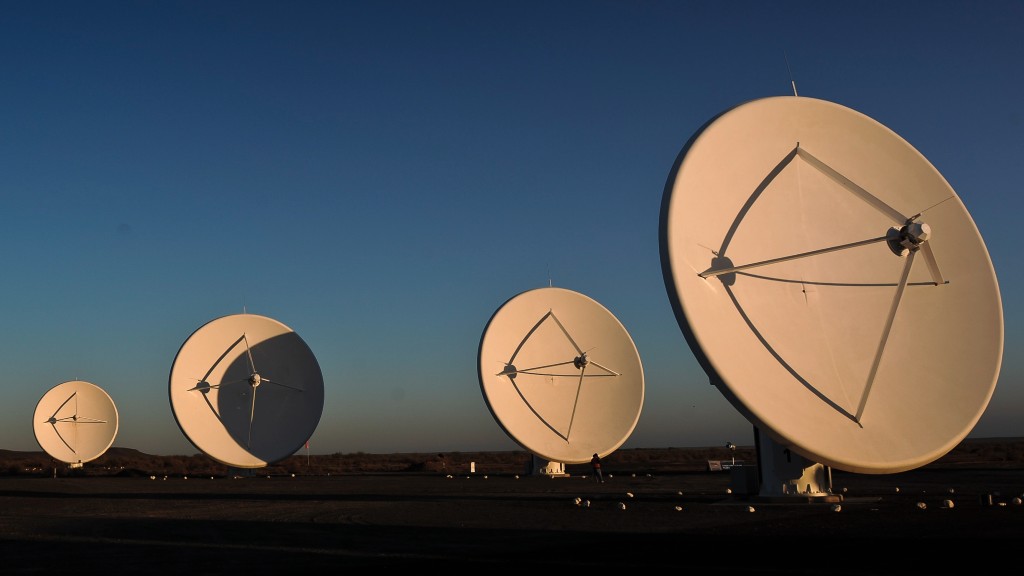The feature of light absorption by the hydrogen surrounding early galaxies could be used as a fresh new probe into the mysteries of dark matter and how it affected the evolution of the universe during the cosmic dark ages.
Scientists have long assumed that dark matter, a mysterious substance that makes up about 85% of the matter in the universe, played a large role in the formation of early galaxies. But since dark matter does not interact with light (unlike the “normal” matter that stars, planets, and us are made of), its nature remains unknown. This means that the precise role they played when galaxies began to form still represents a gap in cosmological models.
To investigate this mystery, scientists from Northeastern University in China and the National Astronomical Observatories of the Chinese Academy of Sciences (NAOC) have proposed a new probe to shed light on both the nature of dark matter and the early formation of galaxies.
Related: We’ve never seen dark matter and dark energy. Why do we think they exist?
One possible way to investigate the particles that make up dark matter and their mass is by studying small-scale structures in the universe. The problem comes when trying to do this for a period called the “cosmic dawn,” about 380 million years after the Big Bang, which is when the first stars were just being born. Thus, there were few viable light sources to illuminate this ancient era for astronomers.
But there were atoms during this era, in the form of gas from the lightest chemical element, hydrogen. Like all elements, hydrogen absorbs light in distinct wavelengths, leaving its mark on the light passing through it.
Searching for dark matter in a cosmic jungle
Atomic hydrogen gas in and around the tiny structures that existed during the cosmic dawn, which ended about a billion years after the Big Bang, creates distinct absorption lines at 21 cm, in the radio range of the electromagnetic spectrum. Collectively, these are called the 21cm Forest, which has been proposed as a possible probe of the temperature of gas and dark matter during the cosmic dawn for more than 20 years.
This has remained just a theoretical concept, however, due to the fact that light from this era has been traveling for about 13.4 billion years to reach us. Along the way, it lost energy, stretching its wavelength and lowering its frequency, moving it down the electromagnetic spectrum toward the red region and beyond into the infrared.
The farther away the light source, the more extreme the “redshift” process. With starlight absent, using the 21-centimetre forest as a dark matter probe would require seeing very loud sources like quasars at cosmic dawn, and thus at high redshift. But the signals from such radio sources of this era are dimmer, and it is difficult to identify such high redshift background sources.
However, this situation may be about to change. Not only have a number of high redshift quasars been discovered recently, but the world’s largest radio telescope, the Square Kilometer Array (SKA), began construction in Australia and South Africa in December 2022 and will soon open its sensitive radio eye in the universe. This indicates that the discovery and use of the 21-centimeter forest may soon be possible.
Related: SKA Observatory: A Guide to the World’s Largest Radio Telescopes Coming Soon

The team behind the new study believes that measuring the energy distribution of the 21-centimetre forest, or its “energy spectrum,” would make it a reasonable probe to simultaneously measure the properties of dark matter and the thermal history of the universe.
This can help researchers distinguish between the cold dark matter model of the universe — one with massive dark matter particles that move slowly compared to the speed of light — and the hot dark matter model, with lighter and faster dark matter particles.
“By measuring the one-dimensional energy spectrum of a 21-centimeter forest, we can not only make the probe truly feasible by increasing the sensitivity, but also provide a way to distinguish between the effects of warm dark matter models and the early heating process,” said researcher at the National Astronomical Observatories Yidong Xu, author. contrast to the new study. “We will be able to kill two birds with one stone!”
As long as cosmic heating wasn’t too intense during the cosmic dawn, the low-frequency capabilities of the first stage of SKA processes should mean that scientists can constrain the mass of dark matter particles and the temperature of the gas. If the cosmic heating is too great, the second stage of SKA will see an instrument expand, resulting in the use of multiple background radio sources that present the same limitations.
Since the potential use of the 21-cm Forest as a dark matter probe is linked to observations of high-redshift radio sources, the next step in this research is to identify more sources of radio radiation during the cosmic dawn, including more high-radio quasars and afterglows. Gamma rays.
These sources can then be pursued once SKA begins observing the universe in 2027, allowing astronomers to shed more light on the mysteries of both dark matter and the first galaxies.
The team’s research is presented in the July 6 issue of the journal Nature Astronomy.

“Reader. Infuriatingly humble coffee enthusiast. Future teen idol. Tv nerd. Explorer. Organizer. Twitter aficionado. Evil music fanatic.”
